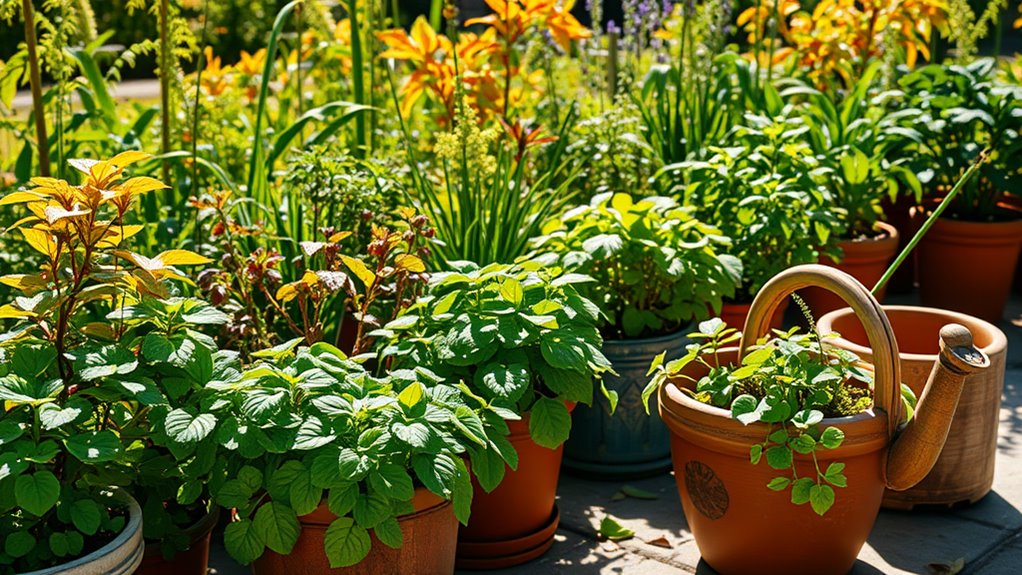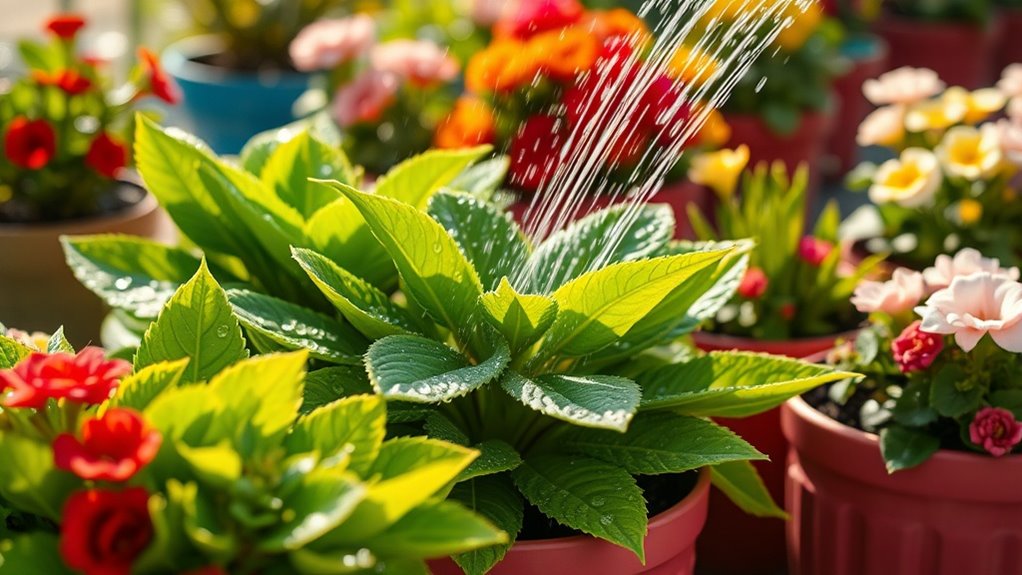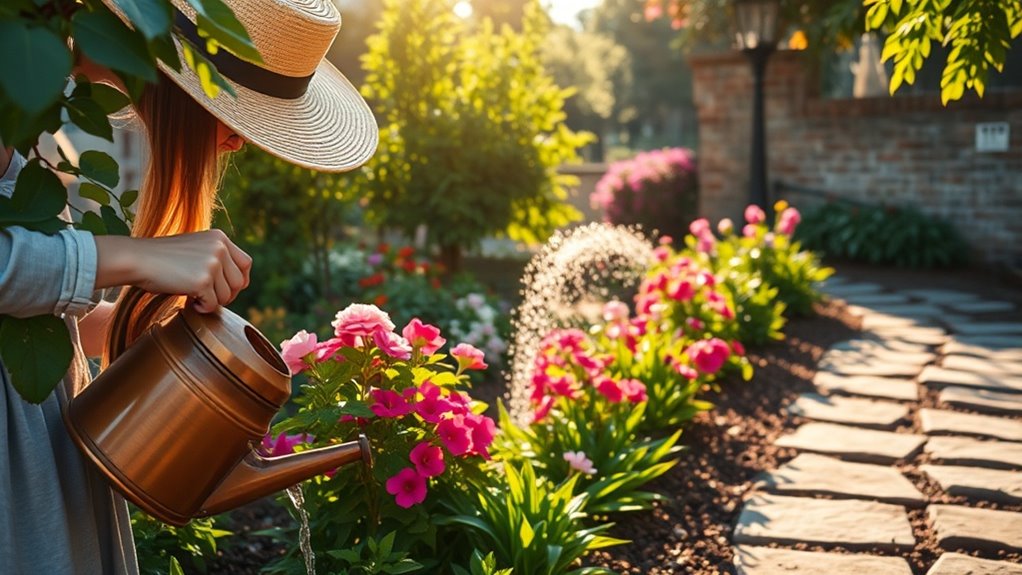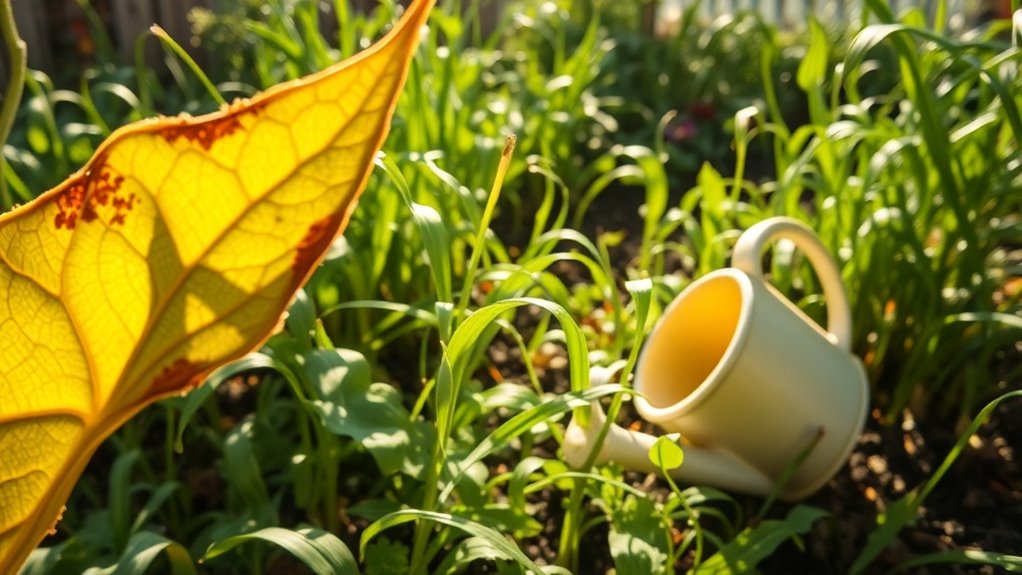Water Your Plants Less by Following These Seasonal Tips
Did you know that nearly 50% of garden water use can be reduced with proper seasonal techniques? By adjusting your watering practices according to the time of year, you can promote healthier plants while conserving water. From spring preparation to winter care, each season requires a different approach. Understanding these methods can make a significant difference in your garden’s health and water efficiency. Let’s explore how to optimize your watering routine throughout the year.
Key Takeaways
- Apply organic mulch in spring to retain moisture and suppress weeds, reducing the need for frequent watering.
- Group plants with similar water needs together to optimize watering efficiency and minimize overall water usage.
- Use drip irrigation systems during summer to deliver water directly to roots, preventing evaporation and conserving water.
- Water deeply but less frequently in fall to encourage strong root growth while adjusting for cooler temperatures.
- Limit winter watering to every 2-4 weeks, ensuring good drainage to prevent root rot in dormant plants.
Understanding Seasonal Water Needs
As the seasons shift, so do your plants’ requirements for water.
In spring, increased sunlight and temperatures mean your plants may need more moisture.
Summer heat can cause rapid evaporation, so be sure to check soil moisture frequently.
Come fall, cooler temperatures and shorter days often reduce water needs, while winter may require minimal watering, especially for dormant plants.
To help retain moisture and reduce evaporation, consider using mulching techniques that can provide additional insulation for the soil.
Use these seasonal watering tips to adjust your routine: always check soil moisture before watering, and consider mulching to retain moisture.
Spring: Preparing Your Garden for Efficient Watering
As spring arrives, it’s time to prepare your garden for efficient watering.
Follow these essential tips to ensure your plants thrive while conserving water:
- Test Soil Moisture: Use a moisture meter or your finger to check if the soil needs watering.
- Mulch: Apply organic mulch to retain moisture and suppress weeds.
- Plan Plant Placement: Group plants with similar water needs together to optimize watering.
- Install a Rain Barrel: Collect rainwater for a sustainable watering source. Additionally, consider incorporating effective collection methods into your rainwater harvesting strategy to maximize conservation efforts.
Summer: Strategies for Hot Weather Watering
What strategies can you employ to keep your garden thriving during the scorching summer months?
Start by watering early in the morning or late in the evening to minimize evaporation.
Use mulch to retain soil moisture and keep roots cool.
Consider drip irrigation systems for efficient water delivery directly to the roots.
Group plants with similar water needs together to avoid over or under-watering.
Monitor your plants closely; signs of wilting indicate a need for water.
Lastly, adjust your watering schedule based on rainfall and temperature changes to prevent overwatering and conserve this precious resource. Implementing water-saving strategies can significantly enhance your garden’s resilience during hot weather.
Fall: Adjusting Watering Practices for Cooler Temperatures
While summer’s heat demands frequent watering, fall introduces cooler temperatures that change your garden’s hydration needs.
As the days get shorter and temperatures drop, it’s crucial to adjust your watering practices.
Here’s how to do it effectively:
-
Water Deeply: Focus on deep watering less frequently to encourage root growth.
-
Check Soil Moisture: Use a moisture meter or your finger to gauge soil dryness.
-
Water in the Morning: This minimizes evaporation and helps plants absorb moisture.
-
Reduce Frequency: Cut back on your watering schedule to prevent over-saturation.
These adjustments will help your plants thrive during the fall months. Additionally, understanding ideal watering practices can ensure your garden remains healthy throughout the changing seasons.
Winter: Protecting Plants From Overwatering
In winter, it’s crucial to adjust your watering frequency to prevent overwatering your plants. Since cooler temperatures slow down evaporation and plant growth, you’ll want to monitor soil moisture closely. Checking the soil regularly helps ensure your plants get the right amount of water without the risk of root rot. Additionally, understanding the effects of overwatering can help you make more informed decisions about your plant care routine.
Adjust Watering Frequency
During winter, you often need to adjust your watering frequency to protect your plants from overwatering.
Cooler temperatures and lower light levels mean your plants’ water needs decrease.
Here are four tips to help you manage watering effectively:
- Reduce frequency: Water less often, typically every 2-4 weeks.
- Check pot drainage: Ensure pots have good drainage to prevent standing water.
- Group plants: Cluster plants with similar needs to simplify care.
- Use a moisture meter: Monitor soil moisture levels before watering to avoid excess.
Monitor Soil Moisture
To prevent overwatering your plants in winter, regularly monitor soil moisture levels. Use a moisture meter or your finger to check the soil’s dampness. Insert your finger about an inch into the soil; if it feels dry, it’s time to water.
Be cautious with watering schedules, as plants typically require less water during colder months. Adjust based on indoor conditions, like humidity and temperature.
Always aim for well-draining pots to prevent excess moisture. Remember, it’s better for plants to be slightly dry than overly wet, as this helps protect their roots from rot during the winter season.
Native Plants: Reducing Water Requirements
Native plants offer an excellent solution for reducing water requirements in your garden.
By choosing plants that are adapted to your local climate, you can create a sustainable landscape that thrives with minimal irrigation. Additionally, many native plants can be edible, providing you with drought-tolerant veggies that can help sustain your garden with even less water.
Here are four benefits of incorporating native plants:
- Drought Resistance: Native plants require less water, especially in dry seasons.
- Low Maintenance: They’re typically easier to care for and don’t need fertilizers.
- Biodiversity: Attract local wildlife, promoting a balanced ecosystem.
- Soil Adaptation: They improve soil structure, enhancing water retention naturally.
Select native plants to enjoy a vibrant, water-efficient garden!
Soil Health: Enhancing Water Retention Techniques
Soil health is crucial for enhancing water retention in your garden, ensuring plants thrive even during dry spells.
Start by incorporating organic matter, like compost or well-rotted manure, to improve soil structure and increase its moisture-holding capacity.
Mulching around your plants with materials like straw or wood chips can also reduce evaporation and keep the soil cool.
Consider using soil amendments, such as clay or coconut coir, to further boost water retention. Additionally, implementing natural tricks for healthier soil can lead to even more effective moisture retention strategies.
Lastly, avoid compacting soil by minimizing foot traffic in planting areas.





